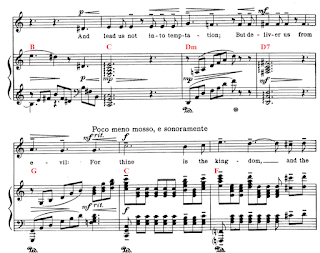Have you ever been handed and asked to perform a piece of
music at the last minute?
Your eyes grow wide.
Your heart starts racing. You may
even begin to sweat.
Saying no may be an acceptable answer, but more often than
not you want to come through and make it work for the person making the request.
There’s not enough time to learn the piece perfectly.
How do you make the most of the time you have?
1. Key
Chances are you will be making up a bit of what you’re
playing or singing. The least you can do
is make it up in the right key.
Once you’ve determined your starting key, look through the
piece for any changes in key or mode, as indicated by a change in key signature
or the addition of accidentals throughout a section of the music.
In order to do this well, you must know your key signatures
and be able to distinguish between major and minor keys. A study of scales and key signatures will
improve your knowledge in this area.
1b. Vocalists: Language
Hopefully, if you’re being handed something at the last
minute, it’s in English, but that won’t always be the case! This is why it is so important to have a general understanding of the following languages: German,
French, Italian, and Spanish.
2. Count
Whether reading alone or with an ensemble, it is crucial to
know where you are within the piece of music.
If you don’t pay attention to the time signature and tempo, you will
very quickly get lost.
Also, if you have to decide between playing the right notes
and playing at the right time, always choose rhythm. There are many tools online and off to help
you master rhythm.
3. Chords
If you’re singing, you may not be aware of the exact chord
progression, but if you know what key you are in, you can be aware of whether a
phrase is ending on a strong note or a weak note or if there are unusual notes,
as indicated by accidentals.
Strong notes are the first and fifth note of the scale (the
Tonic and Dominant). Any other pitches
are considered weaker notes. Focus on
getting the strong notes right and letting the weak notes fill in the gaps.
At the piano, harmony is more important than melody, especially
if you are accompanying. It is your job
as the accompanist to support the melody using the given chords.
Using basic theory knowledge, you can usually reduce difficult
musical sections to a chord symbol or two.
4. Start and End
In everything you do, whether you’re writing, singing,
speaking, or playing, people will remember how you start and how you end. What you do in between is not unimportant, it
is simply less important.
When time is limited, focus on starting and ending well and
let the middle be what it will be.
5. Musical
Believe it or not, it is possible to play and sing wrong
notes beautifully. Dynamics, articulation, and slight changes in tempo can take
a piece of music from mediocre to amazing!
Also, ignoring the expressive markings can be embarrassing in an
ensemble setting.
Application:
Use these tools to tackle the following excerpt from
Malotte’s The Lord’s Prayer:
1. Key: C major! When
in doubt, play a natural note and it will probably sound okay!
2. Count: In the
accompaniment, you have a steady stream of triplet eighth notes. Whether you
are singing or playing, you should have a steady stream of “One-trip-let
Two-trip-let Three-trip-let” going in your mind at all times to keep both
singer and player together.
3. Chords: In the key of C major, C and G are the strong
notes. In this excerpt there are some D# and F# in the melody, so you know just
at a glance that they will sound like they don’t belong. The notes on “For Thine” are a G to a C, so
that will be a strong, important part of the melody!
For the accompanist, it is unnecessary to play every note
written. Using basic theory knowledge,
you can simplify each of the above measures to a single chord, which I have
done in red.
4. Start and End: This excerpt is from the middle of the
piece, but the beginning and the end are both piano only, which is another
reason for accompanists to focus on the beginning and end, since you are often
playing by yourself at that point.
5. Musical: These
seven measures are full of expressive markings, mostly dynamics. How embarrassing would it be to play or sing the
wrong or right note loudly when everyone else is playing softly?
Summary
Next time you’re asked to sight read on the spot, keep these
five tools in mind to make the best of a tricky situation.
Just remember: the 1) Key is to 2) Count the 3) Chords from 4)
Start to End 5) Musically!
Note: These tools are NOT to be used to get you out of a bind when you put off practicing for too long. These tools are for emergency use only!




No comments:
Post a Comment